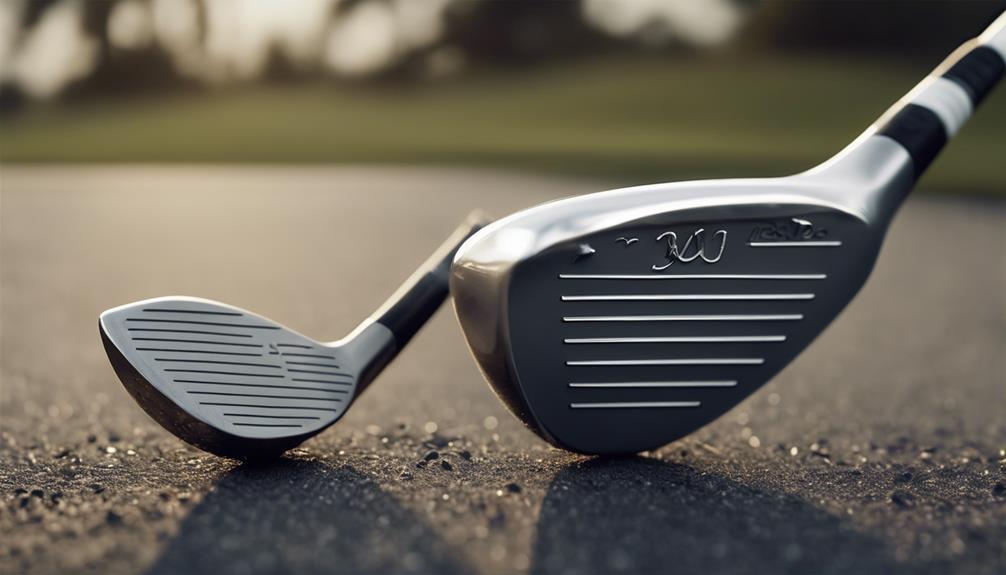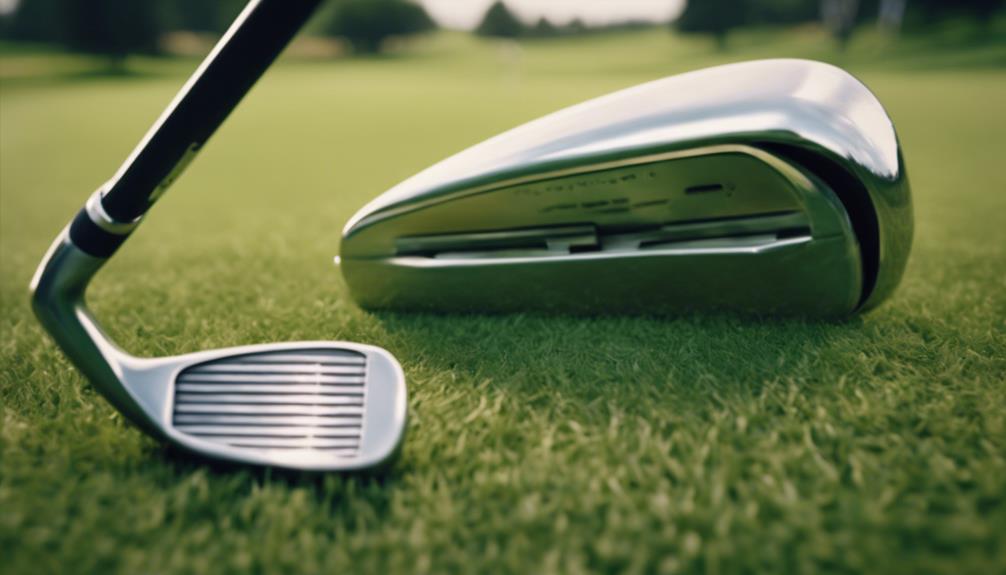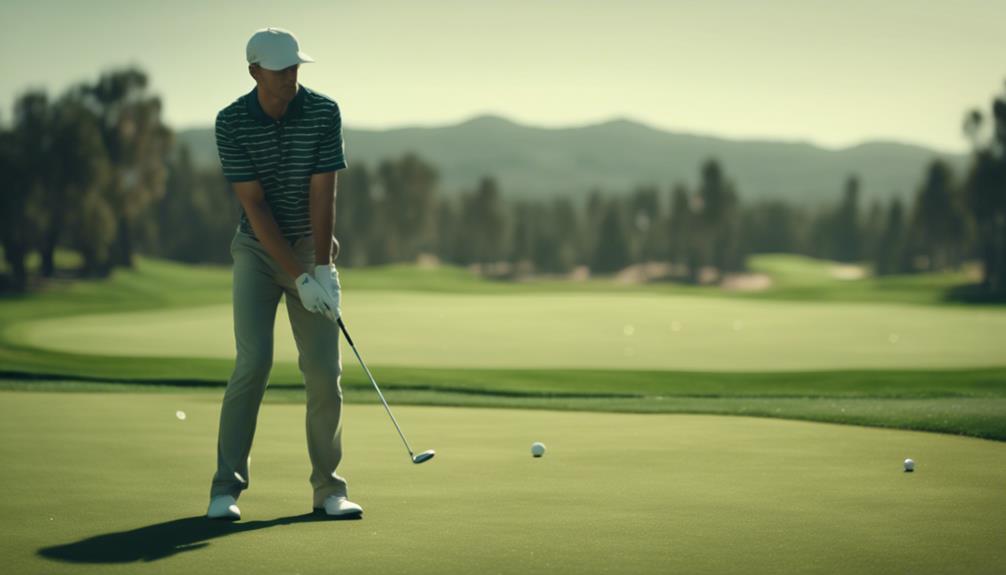- 7 Top Flite Golf Clubs XL for Improved Performance - September 28, 2024
- Top Flite Golf Clubs: Top 5 Reasons to Choose Them - September 28, 2024
- Top 3 Golf Club Fitters for a Perfect Swing - September 28, 2024
You're about to learn how hybrid golf clubs combine the forgiveness of woods with the versatility of irons, designed to deliver higher launch angles and easier ball flight. Hybrids effectively replace difficult long irons, offering wider soles for forgiveness on mis-hits and improved stability. With lofts ranging from 16 to 27 degrees, they provide distance gaps and are suitable for golfers of all skill levels. Now that you know what a hybrid golf club is, you're ready to explore how to choose the right one for your game and access its full potential for improved performance.
Key Takeaways
- A golf club hybrid combines the forgiveness of woods with the versatility of irons, making it easier to hit accurate shots.
- Hybrids are designed for higher launch angles and easier ball flight, with wider soles that enhance forgiveness on mis-hits and improve stability.
- They are available in lofts ranging from 16 to 27 degrees, effectively replacing difficult long irons (1-4) and providing distance gaps.
- Hybrids feature advanced materials like titanium, composite, and high-strength steel alloys, which optimize performance and durability.
Understanding Hybrid Golf Clubs
As you explore the world of golf clubs, it's essential to understand that hybrid golf clubs occupy a unique space in your bag, combining the forgiveness of woods with the versatility of irons to provide a more forgiving and consistent playing experience.
Hybrid clubs are designed to offer higher launch angles and easier ball flight, making them accessible to golfers of all skill levels. With wider soles for enhanced forgiveness on mis-hits, hybrids come in a range of lofts (16 to 27 degrees) to fill distance gaps in your bag.
The shallow head design and low center of gravity promote better control and stability, making them effective for approach shots and from challenging lies. You'll find that hybrids travel 8-12 yards farther than equivalent irons, making them a popular choice for improving distance and accuracy.
As you master your game, you'll appreciate the versatility of hybrids, which can be used for various shots, including teeing off, playing from the fairway, and traversing rough conditions.
Evolution of Woods and Hybrids
You've witnessed a significant transformation in golf clubs over the years, with traditional wooden heads giving way to modern metal woods and, more recently, the emergence of hybrid clubs that have reshaped the game. The evolution of woods and hybrids has been marked by significant advancements in materials and design.
| Club Type | Key Characteristics |
|---|---|
| Traditional Woods | Wooden heads made of hardwoods like persimmon |
| Metal Woods | Constructed from materials like titanium and composites, enhancing performance and durability |
| Hybrid Clubs | Combining features of woods and irons, with a shallower head design and center of gravity positioned closer to the back and bottom |
The introduction of metal woods in the late 1970s and hybrid clubs around 25 years ago have revolutionized the game. Hybrid golf clubs have become increasingly popular, with 1 in 2 golfers carrying at least one hybrid in their bag by 2010. This surge in popularity reflects their effectiveness in replacing long irons and enhancing overall gameplay. As you explore the world of hybrid golf clubs, it is crucial to understand the evolution that has led to their development and widespread adoption.
Design Characteristics and Materials

As you examine the design characteristics and materials of hybrid clubs, you'll notice that manufacturers employ advanced clubhead materials, such as titanium and composite, to achieve superior performance.
You'll also find that modern manufacturing techniques play an essential role in crafting these clubs, allowing for precise control over weight distribution and aerodynamics.
Clubhead Materials Used
Hybrid golf clubs feature clubheads constructed from advanced materials, particularly high-strength steel alloys, which are carefully selected to optimize performance, durability, and forgiveness.
When you look at the clubhead, you'll notice it's designed to provide a larger sweet spot, allowing for more consistent contact and better overall performance. The high-strength steel alloys used in the clubface enhance the club's durability and performance, giving you a reliable and consistent swing.
The materials used in the clubhead also play an essential role in promoting a lower center of gravity, making it easier to launch the ball and achieve higher flights. This design feature is especially beneficial for golfers who struggle with traditional long irons.
Additionally, the clubhead's shallow profile and wide, low-profile sole enhance stability and control, allowing you to strike the ball confidently from various lies, including rough terrain.
Modern Manufacturing Techniques
Modern manufacturing techniques have enabled the production of hybrid golf clubs with shallower heads, strategically positioned centers of gravity, and high-strength steel alloys, resulting in improved control, versatility, and overall performance.
As you explore the design characteristics of hybrid clubs, you'll notice that the shallower head design allows for better control and versatility in various playing conditions.
The center of gravity is typically positioned closer to the back and bottom of the clubhead, promoting easier ball launch and improved accuracy.
The high-strength steel alloys used in hybrid faces provide a larger sweet spot and increased durability, enhancing your overall performance.
You'll also appreciate the wider sole design, which improves forgiveness on mis-hits, making hybrids more user-friendly for golfers of all skill levels.
With available lofts ranging from 16 to 27 degrees, you can customize your distance gaps effectively within your club set.
Titanium and Composite
You'll find that many modern hybrid clubs feature heads made from high-strength titanium or composite materials, which provide a superior strength-to-weight ratio for enhanced performance and durability. These materials allow for the creation of larger clubheads, increasing the sweet spot and improving forgiveness on off-center hits.
Here's a breakdown of the benefits of titanium and composite materials in hybrid clubs:
| Material | Benefits |
|---|---|
| Titanium | Larger clubheads, increased sweet spot, improved forgiveness |
| Composite | Reduced weight, maintained structural integrity, improved swing speed and control |
| Both | Low center of gravity, higher launch angles, easier ball flight |
The strategic use of these materials facilitates the design of hybrids with a lower center of gravity, resulting in higher launch angles and easier ball flight. Additionally, the face of hybrid clubs is typically engineered with a bulged design, which optimizes ball flight and guarantees consistent performance across varying impact points. By leveraging the strengths of titanium and composite materials, modern hybrid clubs offer exceptional performance and playability.
Performance Features and Trends
When it comes to delivering exceptional performance on the course, golfers can rely on hybrid clubs to provide a unique combination of stability, control, and forgiveness.
Hybrids typically feature a wider sole and a low center of gravity, which enhances stability and control while promoting easier ball launch compared to traditional long irons. The loft range for hybrids generally falls between 16 to 27 degrees, allowing them to effectively replace difficult-to-use 1 to 4 irons with a balance of distance and accuracy.
As a golfer, you'll appreciate the larger sweet spot and increased forgiveness on mis-hits, often resulting in greater consistency and improved performance, particularly if you're a high-handicapper.
The design of hybrids, with sharper front edges, also aids in cutting through thick grass, making them effective for playing from rough conditions.
Additionally, adjustability trends in hybrid technology allow you to customize loft and lie angles, tailoring the clubs to better fit your individual swing characteristics and course conditions.
Benefits of Using Hybrid Clubs

When you use hybrid clubs, you'll experience a range of benefits that can elevate your game.
You'll find it's easier to hit shots with precision and accuracy, thanks to the club's design features and larger sweet spot.
Hybrid Club Advantages
By incorporating hybrid clubs into their bags, golfers of all skill levels can experience a significant boost in overall playability, thanks to the unique combination of distance, accuracy, and loft they provide.
Specifically, hybrids offer a reliable replacement for long irons (1-4), which are notoriously difficult to master. You'll find that hybrids travel 8-12 yards farther than equivalent irons, making it easier to achieve consistent ball flight and improved distance.
The larger sweet spots and more forgiving designs of hybrids also reduce score variability by performing well even on off-center hits. Additionally, the shallow head design and low center of gravity promote easier ball launch and higher trajectory, making them ideal for various course conditions, including rough and approach shots.
With their lightweight construction, hybrids facilitate easier swings and less fatigue, contributing to greater confidence and consistency during play.
Easy to Hit Shots
You'll quickly discover that hybrid clubs make it surprisingly easy to hit accurate shots, even for those who struggle with traditional long irons, thanks to their innovative design and weight distribution.
As you swing, you'll appreciate the increased distance and higher launch angle that hybrid clubs provide, often traveling 8-12 yards farther than equivalent irons. This is due to their clever design, which allows for a more forgiving and consistent performance.
The wider sole design of hybrids also enhances forgiveness on mis-hits, enabling you to achieve cleaner shots regardless of your skill level. This feature is particularly useful in challenging conditions, such as rough, where hybrids cut through long grass more effectively than traditional irons.
Furthermore, the larger sweet spot of hybrid clubs facilitates better contact with the ball, contributing to improved accuracy and confidence during play.
Improved Shot Accuracy
Hybrid clubs considerably boost shot accuracy by providing a larger sweet spot, which enables consistent performance even on off-center hits. This means you'll experience fewer mishits and more precise shots, resulting in better overall accuracy.
The design of hybrids, with their low center of gravity and wider soles, allows for easier ball launch and improved control, leading to more precise shots. Studies have shown that hybrids can travel 8-12 yards farther than equivalent irons, translating to improved approach accuracy on the course.
Moreover, the forgiving nature of hybrid clubs helps you achieve a straighter flight path, reducing the likelihood of slices and hooks during play. You'll find that hybrids are particularly effective in rough conditions, cutting through grass more easily than long irons and maintaining accuracy in challenging situations.
With hybrids, you can expect more consistent results, even when faced with difficult lies or uneven terrain. By incorporating hybrid clubs into your bag, you'll notice a significant improvement in your overall shot accuracy, leading to better scores and a more enjoyable game.
When to Use Hybrid Golf Clubs
In situations where accuracy and control are paramount, such as approach shots or difficult lies, hybrid golf clubs prove to be an invaluable addition to your bag. You'll find that these clubs excel in scenarios where traditional irons might falter.
For instance, when faced with challenging approach shots, hybrids deliver a higher trajectory and greater accuracy, allowing for controlled landings on greens. Additionally, they're ideal for maneuvering through tough course conditions, such as hitting from the rough, where their design enables them to cut through thick grass with ease.
You'll also appreciate the distance hybrids provide, comparable to fairway woods, while maintaining a higher level of control and consistency. When you're struggling with long iron shots, hybrids can be a game-changer.
By incorporating them into your bag, you'll experience increased forgiveness and an easier ball launch. To get the most out of your hybrid, take the time to test different models and find the one that best suits your swing style and the courses you play.
With the right hybrid, you'll be confident and consistent on the course.
Hybrid Clubs Vs. Long Irons

As you've experienced the benefits of hybrid clubs in challenging situations, it's natural to wonder how they compare to traditional long irons, and whether they can effectively replace them in your bag.
The answer lies in their design features and performance. Hybrid clubs are designed to replace long irons (1-4), offering a more forgiving and higher-launching alternative that can improve accuracy and distance for many golfers.
You can expect hybrids to travel 8-12 yards farther than their equivalent long irons, thanks to their larger sweet spot and enhanced control. The loft of hybrids, ranging from 16 to 27 degrees, allows you to achieve similar distances to traditional long irons while benefiting from easier swings.
Additionally, hybrids feature a wider sole and lower center of gravity, which aids in cutting through rough and promoting better ball contact compared to long irons.
With 1 in 2 golfers carrying a hybrid in 2010, compared to just 1 in 12 in 2004, it's clear that hybrid clubs have become a popular choice as a replacement for long irons.
Choosing the Right Hybrid Club
When stepping up to replace your long irons, you'll want to carefully select a hybrid club that aligns with your swing style, skill level, and course strategy.
Consider the loft range, typically between 16 to 27 degrees, which affects the trajectory and distance of your shots.
Evaluate the club length and shaft material, as these factors influence swing speed and overall performance. Graphite shafts, for instance, offer lighter weight and flexibility.
Assess your skill level and playstyle, as hybrids are designed to replace long irons (1-4) and should be matched to your distance gaps for peak use.
Don't forget to test various brands and models to find a hybrid that feels comfortable and meets your performance expectations. A professional fitting can be a valuable option.
Finally, analyze course conditions and specific shot scenarios to determine the necessary features of your hybrid, ensuring it complements your overall club selection for versatility and effectiveness.
Tips for Using Hybrid Golf Clubs

By mastering a few key techniques, you can access the full potential of your hybrid golf clubs and start seeing significant improvements in your game.
To get the most out of your hybrids, follow these essential tips:
- Choose the right loft: Select a hybrid with a loft that suits your swing style and the shot you're trying to achieve. Hybrids typically range from 16 to 27 degrees, making them effective replacements for 1-4 irons while providing higher launch angles.
- Take advantage of the sole design: The wider, low-profile soles of hybrids enhance stability and control, allowing for better performance on various course conditions, including thick grass.
Maximizing Hybrid Club Performance
You can access the full potential of your hybrid clubs by carefully selecting the right loft, testing various models, and regularly reassessing your distances to guarantee peak performance. The ideal loft for you will depend on your swing speed and playing style, with options ranging from 16 to 27 degrees. To find the perfect fit, test hybrids with different lofts and pay attention to the launch angle and distance.
| Loft (degrees) | Swing Speed (mph) | Launch Angle |
|---|---|---|
| 16-19 | 70-85 | 12-15° |
| 20-23 | 85-100 | 15-18° |
| 24-27 | 100+ | 18-20° |
Frequently Asked Questions
When Should You Use a Hybrid Golf Club?
When facing challenging lies or long approach shots, you should use a hybrid golf club, leveraging its benefits of increased accuracy, higher trajectory, and forgiveness to consistently land on greens with confidence.
Does Tiger Woods Use Hybrids?
You're wondering if Tiger Woods uses hybrids? Well, despite experimenting with them, Tiger's preferences lean towards traditional long irons and fairway woods, suiting his skill set and playing style, with hybrids rarely making it into his tournament bag.
Can I Tee off With a Hybrid Club?
You can confidently tee off with a hybrid club, leveraging its benefits: higher launch angles, greater forgiveness, and a lower center of gravity, which provide improved control, consistency, and accuracy, making it an ideal choice for various course conditions.
How Many Hybrids Should I Carry?
When selecting hybrids, you'll want to contemplate your skill level, play style, and course conditions to determine the ideal number, typically between one to three, that fills distance gaps and enhances your overall Hybrid Selection.
Conclusion
As you stand on the tee, hybrid club in hand, you're about to release a powerful fusion of technology and precision.
Like a master painter blending colors, you'll merge the distance of a wood with the control of an iron, creating a stroke of genius.
With each swing, the hybrid's advanced materials and design harmonize, producing a symphony of accuracy and power.
The result? A shot that's a work of art, leaving all others in its wake.




